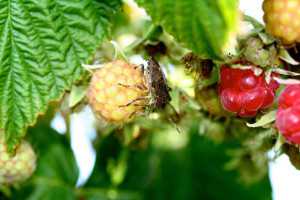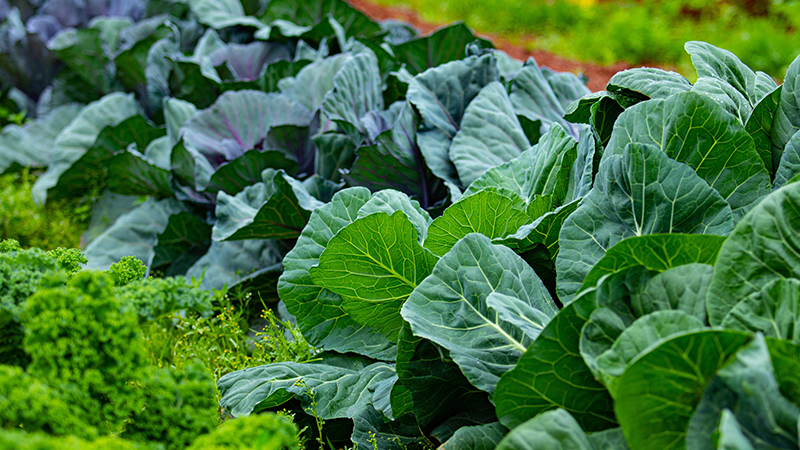PNW Fruit Growers Keeping Tabs On Stink Bug
 For the past five years or so, the brown marmorated stink bug (BMSB, Halyomorpha halys) has been a major concern for fruit growers in the Eastern U.S., particularly those in the Mid-Atlantic region. While it was first detected in the U.S. in the late 1990s, BMSB really began making headlines around 2008 when it devastated peach and apple orchards, causing as much as 80% or more fruit loss in some areas.
For the past five years or so, the brown marmorated stink bug (BMSB, Halyomorpha halys) has been a major concern for fruit growers in the Eastern U.S., particularly those in the Mid-Atlantic region. While it was first detected in the U.S. in the late 1990s, BMSB really began making headlines around 2008 when it devastated peach and apple orchards, causing as much as 80% or more fruit loss in some areas.
Since then, growers in the Pacific Northwest have been on alert for the potential movement of BMSB across the country. Inevitably, around 2011, BMSB made its presence known in Portland, OR. Like in the East, it started out as a nuisance pest for homeowners, but is now being found on a limited scale in commercial orchards.
However, this time the industry was ready. “I think we are fortunate to be in the position of being able to anticipate the threat from this pest, whereas they were largely taken by surprise in the Mid-Atlantic states when this pest suddenly made the jump from urban nuisance to severe crop pest,” says Nik Wiman, a postdoctoral associate in the Department of Horticulture at Oregon State University. “We also are benefiting from the knowledge base being generated by researchers from the Mid-Atlantic.”
Just The Facts
Brown marmorated stink bug is identifiable by white bands on its antenna, its smooth anterior shoulder, and a banding pattern on its abdominal region. It goes through five nymphal instars before reaching the adult stage, and can cause damage in all but one of these growth stages. While color and design patterns might vary depending on the nymph stage, the white antennal bands will be consistent.
What makes the BMSB both destructive and difficult to manage? The biggest problem is that it can cause crop damage at almost any stage of development, and its piercing and sucking mouthparts directly damage the fruit, making the crop unmarketable. It also reproduces both in and outside the orchard, and it can move into the orchard early in fruit development and right before harvest time.
Growers in the east know all too well how BMSB can wreak havoc with IPM programs. Because movement of the pest into orchard blocks is difficult to predict and hard to observe, growers have moved to more frequent spray intervals. They have also had to rely on some broad-spectrum chemistries, which can be very hard on biological control, increase the risk of resistance, and also increase the chance of secondary pest outbreaks such as mites and aphids. According to Wiman, even intensive spray programs have resulted in damage approaching 50% in some peach and apple orchards.
Rapid Expansion
In the Pacific Northwest, the BMSB emerged as a nuisance problem in residential areas in greater Portland in 2011. Because they saw how quickly it became a significant agricultural pest in the east, state ag officials soon began actively sampling in potential target areas. They sought to determine a threshold of awareness among the public, educated homeowners in key areas on how to identify it, and set up an email address ([email protected]) where people could send questions.
2012 saw major expansion of BMSB into the Columbia Gorge, the Willamette Valley, and in desert regions east of the Cascade Mountains. It was also in the Willamette Valley where it first started showing up on farms, mainly in hazelnut, tree fruit, blackberry, and grape farms and vineyards not far from urban areas.
By 2013, BMSB had firmly established populations in desert regions of southern and eastern Oregon. Bugs were detected in higher numbers on farms in the Willamette Valley, and the first reports of economic damage to commercial crops came from an apple, Asian pear, and pepper grower in Vancouver, WA.
During this time frame, Wiman and his colleagues have been able to identify potential host plants and areas. For example, he points out that the Willamette Valley, where BMSB had early population growth, is somewhat similar to the areas of Pennsylvania, Virginia, and West Virginia, where BMSB first became a problem in the east. Each of these regions has small diverse farms, many of which border hardwood forests. Some areas of Wenatchee, WA, and Hood River are also similar. In contrast, the larger farms of the Mattawa, WA, and Columbia Basin regions, with fewer hardwood forests, may not pose as much of a risk for BMSB emergence.
A few native and exotic host species have also been identified. Exotic hosts include the “Tree of Heaven” (ailanthus), which has high drought tolerance, and the Himalayan blackberry. The red osier dogwood and maple trees are considered important native hosts.
The Problem With Trapping
The primary goal in BMSB management is to do so without relying on a heavy dose of applications. Ideally, management would start with trapping; however, there are behavioral and technological barriers that have prevented the development of a proven trapping system. For one thing, the response by BMSB to trapping systems may differ early in the season versus late in the season.
“A lot of growers and IPM professionals want to know about traps,” says Wiman. The problem with trapping for BMSB is that they haven’t worked well in the early season. “Partly this was because we were relying on cross attraction of BMSB to a pheromone for a related stink bug called Plautia stali,” he says. Until now, all lures labeled BMSB were actually this pheromone; the active component is called MDT or methyldecatrienoate. Wiman notes that Tracy Leskey, at USDA’s Kearneysville, WV, research center, and colleagues have developed the true aggregation pheromone for BMSB, and it is in the patent process. This lure, referred to as #10 (pure form) or #20 (less expensive and pure but just as effective) has made early detection a reality, particularly when it is used with a synergist.
There are a number of pheromone companies that are ready to release a commercial version of these lures to the public when the patent process is fully completed. However, “we still don’t know the implications of trap catch of BMSB,” says Wiman. “For example, we have no data that relate trap catch to damage, and a big frustration has been that trap catch does not seem to reflect on population densities.” Therefore, Wiman does not recommend that these traps are placed in commercial crops at this time by growers or consultants, at least for true measurements of activity. They may be more effectively used for detection.
Through the Washington Tree Fruit Research Commission, Wiman is currently working with Jay Brunner (Washington State University), Peter Shearer (Oregon State), and Leskey and Ashot Khrimian with the Agricultural Research Service on a project to improve early detection of BMSB. One tool that is being examined is interspersing of light with pheromone traps for detection of BMSB at the edge its expanding range. Trials across Oregon and Washington last year showed that BMSB was captured in three of 10 sites using this trap configuration. In many cases, the light traps helped bring BMSB from a distance, and they were then captured in the pheromone traps. More information on this study can be found at 1.usa.gov/1cWTKPE. Another aspect of this research is evaluating volatile components of favorite host plants of BMSB for their potential to attract BMSB to traps. It is possible that host plant volatiles incorporated into lures could improve early season attraction to traps.
What’s Next
Wiman notes that the experiences of growers and researchers across the country have been helpful for those in the west. “We have the gift of time. We know that it took from 1996 to 2010 for the severe problems to develop out East,” says Wiman. “Here in Oregon, our history with BMSB began in 2004, so we are going on year 10. However, particularly in Western Oregon and Washington, we have much more temperate winters than they do in the Mid-Atlantic region, and we also have long summers. This past summer we found out that BMSB can complete two full generations in Oregon, rather than just one as we previously assumed. Given these observations, our team feels that it will take less than 14 years for BMSB to reach the same threat level as the Mid-Atlantic.”
Fortunately, the extra time provides an opportunity for management tactics such as classical biological control, says Wiman. “There is an egg parasitoid that is being evaluated by USDA and is being tested in Oregon by the Oregon Department of Agriculture and Oregon State University. There is potential that early release of this natural enemy of BMSB will head off the looming threat of BMSB on the West Coast.”
What else is planned in 2014? “We will continue to focus on improving trap technology and BMSB detection, as well as studies of phenology, with the ultimate goal of developing models to predict BMSB life history, characterizing damage and impacts of BMSB in specialty crops, and studies of feeding behavior and trying to determine potential feeding deterrents,” says Wiman. “We will also continue with our statewide sampling and monitoring.”
Five Things You Need To Know
The extended growing season in 2013, coupled with the two generations of brown marmorated stink bug (BMSB) that occurred, meant that there was massive population growth in the region last year. As a result, Nik Wiman, postdoctoral associate in the Department of Horticulture at Oregon State University, expects that many growers will experience BMSB for the first time on their farms in 2014. He mentions five things these growers need to know:
1. The likelihood of encountering BMSB is strongly linked to where you are. Farms in the northern Willamette Valley have the highest risk. Proximity to urban areas can be a factor, but we now have BMSB in natural environments, particularly where there are hardwoods or invasive trees. The Columbia Gorge is another area where risk is increasing.
2. Get your potential BMSB specimen identified or confirmed by your local Extension agent. There are many native stink bugs, some of which are even beneficial. Some strongly resemble BMSB.
3. Don’t panic. The first time you find BMSB in your crops or on borders you are unlikely to have a population sufficient to cause damage. We have seen many cases where BMSB is present in border vegetation but has not attacked crops.
4. Late-season crops are most at risk. Late-season is a time when the menu for BMSB is shrinking and populations are at their peak.
5. Avoid bringing bugs to your farm. If you travel to areas where there are large populations of BMSB such as Portland OR, Vancouver WA, or Hood River, OR, it pays to check your vehicle for hitch-hiking BMSB that may have landed on your rig. Just parking your car for an hour or less along a shady street in an infested area is a great way to pick up bugs and transport them.










